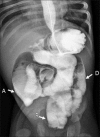Case report: Congenital short bowel syndrome
- PMID: 21042453
- PMCID: PMC2963747
- DOI: 10.4103/0971-3026.69366
Case report: Congenital short bowel syndrome
Abstract
Congenital short bowel syndrome (SBS) is a relatively rare condition as compared to acquired SBS. It is associated with significant mortality and morbidity. Infants usually present with failure to thrive, recurrent vomiting, and diarrhea. It is important to suspect and diagnose this condition promptly, as early initiation of parenteral nutrition or surgery, if necessary, may result in a favorable outcome. We discuss a case of an infant aged 26 days, who presented with failure to thrive, recurrent vomiting, and weight loss. A contrast study of the gastrointestinal tract revealed a short small bowel, with malrotation. The infant was started on parenteral nutrition, but succumbed shortly thereafter to severe disseminated sepsis.
Keywords: Congenital; malabsorption; short bowel syndrome.
Conflict of interest statement
Figures



References
-
- Hamilton JR, Reilly BJ, Morecki R. Short small intestine associated with malrotation: A newly described congenital cause of intestinal malabsorption. Gastroenterology. 1969;56:124–36. - PubMed
-
- Navarro F, Gleason WA, Rhoads JM, Quiros-Tejeira RE. Short bowel syndrome: Epidemiology, pathophysiology and adaptation. Am Acad Pediatr. 2009;10:330.
-
- Siebert JR. Small -intestine length in infants and children. Am J Dis Child. 1980;134:593–5. - PubMed
-
- Sansaricq C, Chen WJ, Manka M, Davis D, Snyderman S. Familial congenital short small bowel with associated defects: A long term survival. Clin Pediatr (Phila) 1984;23:453–5. - PubMed
Publication types
LinkOut - more resources
Full Text Sources

